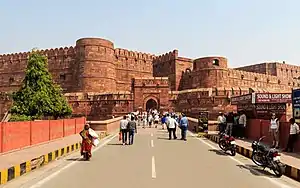Capture of Agra
The Capture of Agra Fort ended a month-long siege by Suraj Mal on 12 June 1761 after Surajmal promised Qiledar 1 lakh rupees in cash and five villages.[6] The Jats occupied Agra. It remained in possession of Bharatpur State rulers until 1774.[7]
| Capture of Agra Fort | |||||||||
|---|---|---|---|---|---|---|---|---|---|
| Part of Mughal-Jat Wars | |||||||||
 Agra Fort in modern time. | |||||||||
| |||||||||
| Belligerents | |||||||||
|
|
| ||||||||
| Commanders and leaders | |||||||||
|
| Mughal Qiledar | ||||||||
Background
Jats began to expand the boundaries of their kingdom. They expanded their territory to eastern Rajasthan, western Uttar Pradesh, southern Haryana, and Delhi. The Jat ruler of Bharatpur Suraj Mal controlled over the Braj region. Agra had to be merged with his territory to dominate.
Battle
Surajmal's army (four thousand Jat soldiers) advanced towards Agra. After a month's siege, on 12 June 1761, Surajmal offered peace terms and promised Qiledar one lakh money with five villages and Agra fort came under the control of Surajmal. They also melted the two silver doors of the famous Mughal monument Taj Mahal. It remained under the control of Bharatpur rulers until 1774.[7] After the Jats captured the fort of Agra, the Jats had stuffed straw in the Taj Mahal of Agra.
Aftermath
After capturing Agra Fort, Suraj Mal became more powerful and dominant. He now became the ruler of the area of Yamuna. For the Jats, the capture of Agra was an emotional moment. About 90 years ago, just a short distance away from the gate of this fort, Gokula was cut and thrown. Surajmal thus avenged himself. Jats ruled Agra for 13 years from 1761 to 1774.[7] In 1774 the Mughal Commander Mirza Najaf Khan re-captured Agra.
See also
References
- Maheshwari, Anil (1996). Taj Mahal: Moon Still Shines : an Environmental Mess. Ajanta Publications.
- Bhatia, O. P. Singh (1968). History of India, from 1707 to 1856. Surjeet Book Depot. p. 536.
- Sarkar, Sir Jadunath (1950). Fall of the Mughal Empire: 1754–1771. (Panipat) 2d ed., rev. 1950. M.C. Sarkar.
- "University of Kerala. Dept. of History, University of Allahabad. Dept. of Modern Indian History, University of Kerala, University of Travancore". Journal of Indian History, Volumes 48–49. University of Kerala. 1970.
- Edwardes, Michael (1970). King of the World: the Life and Times of Shah Alam: Emperor of Hindustan. Secker & Warburg. ISBN 9780436140914.
- Sarkar, Sir Jadunath (1950). Fall of the Mughal Empire: 1754–1771. (Panipat) 2d ed., rev. 1950. M.C. Sarkar. pp. 143–144.
- Bhanu, Dharma (1979). The Province of Agra: Its History and Administration. Concept Publishing Company. p. 9.